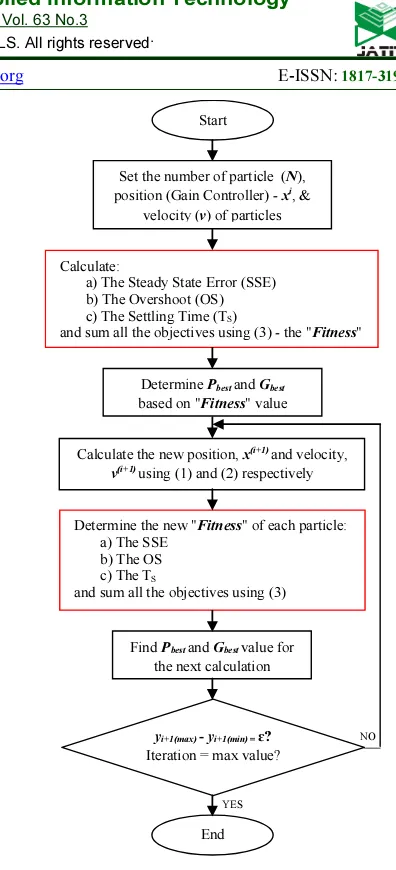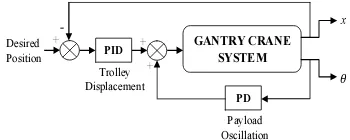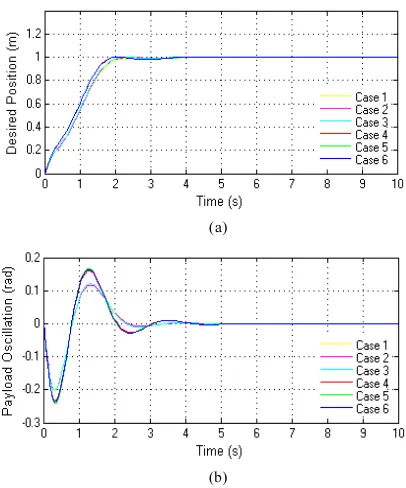ISSN: 1992-8645 www.jatit.org E-ISSN: 1817-3195
EFFECTS OF MULTIPLE COMBINATION WEIGHTAGE
USING MOPSO FOR MOTION CONTROL GANTRY CRANE
SYSTEM
1H.I. JAAFAR, 2Z. MOHAMED, 3J.J. JAMIAN, 4M.S.M. ARAS, 5A.M. KASSIM, 6M.F. SULAIMA
1Lecturer, Center of Robotics and Industrial Automation (CeRIA), Faculty of Electrical Engineering,
Universiti Teknikal Malaysia Melaka, 76100 Durian Tunggal, Melaka, Malaysia
2Assoc. Prof., Department of Control and Mechatronic Engineering, Faculty of Electrical Engineering,
Universiti Teknologi Malaysia, 81310 Skudai, Johor, Malaysia
3Senior Lecturer, Department of Power Engineering, Faculty of Electrical Engineering,
Universiti Teknologi Malaysia, 81310 Skudai, Johor, Malaysia
4Senior Lecturer, Department of Mechatronic Engineering, Faculty of Electrical Engineering,
Universiti Teknikal Malaysia Melaka, 76100 Durian Tunggal, Melaka, Malaysia
5Senior Lecturer, Department of Mechatronic Engineering, Faculty of Electrical Engineering,
Universiti Teknikal Malaysia Melaka, 76100 Durian Tunggal, Melaka, Malaysia
6Lecturer, Department of Industrial Power Engineering, Faculty of Electrical Engineering,
Universiti Teknikal Malaysia Melaka, 76100 Durian Tunggal, Melaka, Malaysia
E-mail: [email protected], [email protected], [email protected], [email protected],
5[email protected], 6[email protected]
ABSTRACT
This paper presents the implementation of Multi Objective Particle Swarm Optimization in controlling motion control of Gantry Crane System. Three objective functions are considered to be optimized, named (i) steady state error, (ii) overshoot, and (iii) settling time. Six cases with different setting of weight summation are analyzed in order to obtain five parameters (PID and PD) controller. A combination of PID and PD controller is observed and utilized for controlling trolley movement to desired position and reduced the payload oscillation concurrently. Various cases of weight summation values will affect to the controller parameters and system responses. The performances of the system is conducted and presented within Matlab environment.
Keywords: Computational Intelligence, Gantry Crane System, Motion Control, PID Controller, Multi
Objective Particle Swarm Optimization (MOPSO)
1. INTRODUCTION
Gantry Crane System (GCS) have two main points to be considered which are position of the trolley and oscillation of the payload. Trolley should move as fast as possible while payload should not give huge impact on the swing angle which can harm the surroundings environment. These two factors will be determining the stability of motion for GCS performance. In dealing with these issues, a control mechanism that account for position of the trolley and oscillation of the payload is required in order to move the trolley as fast as possible with low payload oscillation.
Various control techniques have been proposed previously for controlling the GCS. In industrial
Several investigations have been conducted to optimize PID controller parameters especially based on intelligent techniques. For instance, Genetic Algorithm (GA) has been applied to tune PID for automatic GCS [3]. Furthermore, Artificial Bee Colony (ABC) algorithm is introduced to tune the PID controller. It was employed to tune for higher order plant and the results shows that overshoot and settling time can be improved [4]. In addition, Ant Colony Algorithm (ACA) was proposed to optimize the parameter of the controller in designing of a nonlinear PID controller. It has flexible and adaptive characteristic in order to find the PID parameters. Satisfactory overall performance of the system has been demonstrated with the controller [5]. Another optimization technique that can be utilized for finding optimal PID parameters is Firefly Algorithm (FA). It has been tested where FA is more powerful and shows superior performances compared to GA for PID controller parameter tuning of the considered nonlinear control system [6]. Nevertheless, since Particle Swarm Optimization (PSO) is well known as simple optimization compared to the other of some optimization method, thus it is being chosen to be implemented for this work.
Particle Swarm Optimization (PSO) is one of the meta-heuristic methods and introduced in 1995 [7]. The strength of PSO is fast convergence compares with many global optimizations. The calculation is very simple and speed of the researching is very fast [8]. It works effectively to drive nonlinear plant and high order system [9]. In addition, PSO could find for less overshoot and minimize the error [10]. Besides that, PSO is also investigated for obtaining PID parameters for GCS and it is well known for simple optimization compared to the other optimization methods [3, 9, 11-14]. However, most of existing works for controlling GCS by using PSO with a single objective. Thus, Multi Objective PSO (MOPSO) is used in this analysis to balance the impacts of PID tuning process to the GCS performances.
In this work, MOPSO algorithm based on six cases of various weight summation approaches and pattern of five combination parameters (PID and PD) controller will be tested and investigated. The idea of this analysis is based on [13]. The effectiveness of combination values for PID and PD controller parameters is very critical to be discussed. Thus, combination of these parameters will determine whether motion control of GCS will
affect to system response or not. Therefore, an increase or decrease in value of controller parameters will be analyzed in this work.
2. MULTI OBJECTIVE PARTICLE SWARM
OPTIMIZATION
In the original Particle Swarm Optimization (PSO), only single objective function is considered [7]. Multi Objective Particle Swarm Optimization (MOPSO) is developed based on basic of PSO technique. MOPSO has helped a lot in solving the multi objective problems. Many types of MOPSO have been proposed by researchers [15-18]. The only different between these two methods is on the number of objective function that is trying to be optimized [13].
Linear Weight Summation (LWS) approach is used in MOPSO algorithm due to the simplest and the most popular method. Multi objective function is converted to a single objective function. In MOPSO, a set of particles are initialized in the decision space at random. The process of finding the updating particles’ position and velocity are similar as shown in equation (1) and (2) respectively, but the selection on local best (Pbest)
and global best (Gbest) is depending on “Fitness” value given by equation (3).
ISSN: 1992-8645 www.jatit.org E-ISSN: 1817-3195
equation of these three objective functions is shown
in equation (3).
i T w
i OS w i SSE w
i Fitness
S T
OS SSE
S( )
) ( )
(
+
+ =
(3)
where:
w
SSE
=
weight value for the steady state errorw
OS=
weight value for the overshootw
Ts
=
weight value for the settling timeFigure 1 shows the flow chart for MOPSO in searching the controller value for GCS parameters. According to the figure, the process of weight summation for determining the Fitness value is done just before the step to determine the Pbest and
Gbest (in the Red boxes). After that, the updating process is taking place until reach the stopping criterion; either the fitness value among the particles is less than ε value or the MOPSO algorithm has reached the maximum iteration that is set by the user. By using this algorithm, the optimal PID and PD parameters value for the GCS will be investigated in this study.
In this analysis, MOPSO is used to balance the impacts of PID and PD controller tuning process for GCS performances. By implementation of MOPSO algorithm, various performance results are produced according to desired response. Simulation results have been demonstrated satisfactory responses under various cases of conditions based on control system performances.
Set the number of particle (N), position (Gain Controller) - xi
, & velocity (v) of particles
Calculate:
a) The Steady State Error (SSE) b) The Overshoot (OS) c) The Settling Time (TS)
and sum all the objectives using (3) - the "Fitness"
Determine Pbestand Gbest based on "Fitness" value
NO
YES
Calculate the new position, x(i+1)
and velocity,
v(i+1)using (1) and (2) respectively
Determine the new "Fitness" of each particle: a) The SSE
b) The OS c) The TS
and sum all the objectives using (3)
Find Pbestand Gbestvalue for the next calculation
yi+1(max) - yi+1(min) = ɛ?
Iteration = max value?
End Start
Figure 1: Process of MOPSO in Determining GCS Parameters
3. MODEL OF GANTRY CRANE SYSTEM
Figure 2: Model of GCS
Figure 2: Model of GCS
Table 1: System Parameters for GCS Model.
Parameters Symbol Value Unit
Payload mass m1 1 kg
Electric constant KE 0.007 Vs/rad
Radius of pulley rP 0.02 m
Gear ratio z 15 -
4. EQUATIONS
Standard form of Lagrange's equation is given as:
i nonconservative generalized forces and independent generalized coordinate. The Lagragian function can be written as:
P T
L= − (5)
with T and P are respectively kinetic and potential energies. Thus, kinetic and potential energies can be derived as shown in equation (6):
θ differential equations as:
F complete nonlinear differential equation of GCS can be obtained as equation (9) and (10) where V is
5. RESULTS AND DISCUSSION
A control structure of GCS is developed for simulation purpose as shown in Figure 3. This model is designed based on Figure 2 with development of mathematical modeling equation in equation (9) and (10). In dealing with motion control, a control mechanism with PID and PD controller are required. The purpose of using PID controller is to control position of trolley displacement while PD controller is for reducing payload oscillation.
Figure 3: Control Structure with PID and PD Controller
ISSN: 1992-8645 www.jatit.org E-ISSN: 1817-3195
Table 2: Six Cases with Different Setting of Weight Summation.
Case wSSE wOS wTs Total
1 0.2 0.7 0.1 1.0
2 0.1 0.7 0.2 1.0
3 0.7 0.2 0.1 1.0
4 0.7 0.1 0.2 1.0
5 0.2 0.1 0.7 1.0
6 0.1 0.2 0.7 1.0
Table 3 shows five controller parameters which are represented as KP, KI, KD, KPSwingand KDSwing that obtained by using MOPSO. Various cases of weight summation are studied to observe the pattern of PID and PD parameters for the controller. Based on Figure 4, each case shows almost similar form of increase and decrease for PID and PD parameters. Each of controller parameters is closely interrelated respectively. High value of KP will effect to the increment of overshoot, OS and never eliminate the steady state error, SSE. In order to eliminate the SSE, KIis used with very small value of parameter (0.0015) for all cases. It shown that this controller only requires a small value of KI to ensure the trolley can be arrived at the desired position accurately. However, it may provide high percentages of OSand affect to the settling time, Ts respectively. Thus, KDis required by implementing smaller value than KP to reduce the percentages of OS and improving the transient response. It will give the trolley arrived to the right position as fast as possible. This optimal motion control of the trolley displacement will reduced payload oscillation.
Figure 4: Graph Pattern of Five Controller Parameters (PID and PD)
For oscillation motion control, the value of
KPSwingand KDSwing are needed. The value of KPSwing is higher than KP while KDSwing with small value of parameter to reduce the percentage of OS.
Table 3: Six PID and PD Parameters Using MOPSO Algorithm.
Case KP KI KD KPSwing KDSwing
1 82.2784 0.0015 66.1400 179.7369 0.0015 2 77.2547 0.0015 59.5447 172.6070 0.0032 3 91.1707 0.0015 71.2132 198.4202 0.0015 4 88.5097 0.0015 63.0331 145.5495 0.0015 5 67.5542 0.0015 45.0256 104.0231 0.0015 6 83.6594 0.0015 58.6192 133.8354 0.0015
Figure 5 shows the overall performances of GCS with respect to the six cases of different setting weight summation values.
(a)
(b)
Figure 5: Performances of GCS for Different Cases (a) Trolley Displacement (b) Payload Oscillation
5. CONCLUSION
This paper has presented design of GCS for controlling the trolley displacement and payload oscillation. Mathematical modeling of the system has been derived and used for verification of control algorithm. System responses including motion of trolley displacement and payload oscillation have been examined. In this work, MOPSO algorithm based on six cases of various weight summation approaches to find PID and PD controller parameters has been used. Based on the analysis, the combination weight values will affect to the system responses. The new finding about this method is the trolley is able to move to desired position (1 meter) with zero SSE for all cases. Furthermore, the advantage about MOPSO technique is any selection of weight values depending on the needs of user whether SSE, OS or Ts are set as priority. Results have shown that each of controller parameters is closely interrelated and MOPSO is able to control the motion of trolley displacement and payload oscillation according to the needs and circumstances.
ACKNOWLEDGEMENTS:
Authors would like to thanks Universiti Teknikal Malaysia Melaka (UTeM) for sponsoring this project. This project is funded by the Short Term Research Grant No. PJP/2013/FKE(25C)/S01256. The authors are indebted to Faculty of Electrical Engineering, Universiti Teknologi Malaysia (UTM) for their help in conducting this work.
REFRENCES:
[1] K.J. Astrom, and T. Hagglund, Advanced PID Control, ISA-The Instrumentation, Systems and Automation Society, 2006.
[2] H.I. Jaafar, Z. Mohamed, J.J. Jamian, A.F.Z. Abidin, A.M. Kassim, Z. Ab Ghani, “Dynamic Behaviour of a Nonlinear Gantry Crane System”, Procedia Technology, Vol. 11, 2013, pp. 419-425.
[3] M.I. Solihin, Wahyudi, M.A.S Kamal, and A. Legowo, “Objective Function Selection of GA-Based PID Control Optimization for Automatic Gantry Crane”, International Conferences on Communication Engineering, Kuala Lumpur, Malaysia, May 13-15, 2008, pp. 883-887. [4] M. Abachizadeh, M.R.H. Yazdi, and A.
Yousefi-Koma, “Optimal Tuning of PID Controllers using Artificial Bee Colony”, IEEE/ASME International Conference on
Advanced Intelligent Mechatronics, Montreal, Canada, July 6-9, 2010, pp. 379-384.
[5] Jiajia He and Zaien Hou, “Adaptive Ant Colony Algorithm and its Application to Parameters Optimization of PID Controller”, 3rd International Conference on Advanced Computer Control, Harbin, China, January 18-20, 2011, pp. 449-451.
[6] O. Roeva, and T. Slavov, “Firefly Algorithm Tuning of PID Controller for Glucose Concentration Control during E.Coli Fed-Batch Cultivation Process”, Computer Science and Information Systems, Wroclaw, Poland, September 9-12, 2012, pp. 455-462.
[7] J. Kennedy, and R. Eberhart, “Particle Swarm Optimization”, Proceedings of the 1995 IEEE International Conference on Neural Networks, November 27 – December 1, 1995, pp. 1942-1948.
[8] Q. Bai, “Analysis of Particle Swarm Optimization Algorithm”, Computer and Information Science, Vol. 3, 2010, pp. 180-184. [9] M.I. Solihin, Wahyudi, M.A.S. Kamal, and A.
Legowo, “Optimal PID Controller Tuning of Automatic Gantry Crane Using PSO Algorithm”, Proceeding of the 5th International Symposium on Mechatronics and its Applications, Amman, Jordan, May 27-29, 2008, pp. 1-5.
[10] S.M. Girirajkumar, Deepak Jayaraj, and Anoop. R. Kishan, “PSO based Tuning of a PID Controller for a High Performance Drilling Machine”, International Journal of Computer Application, Vol.1, 2010, pp.12-18.
[11] H.I. Jaafar, Z. Mohamed, A.F.Z Abidin, and Z.A Ghani, “PSO-Tuned PID Controller for a Nonlinear Gantry Crane System”, IEEE International Conference on Control System, Computing and Engineering, Penang, Malaysia, Nov. 23-25, 2012, pp. 515-519.
[12]H.I. Jaafar, N.M. Ali, Z. Mohamed, N.A. Selamat, A.M. Kassim, A.F.Z. Abidin, and J.J. Jamani, “Optimal Performance of a Nonlinear Gantry Crane System via Priority-based Fitness Scheme in Binary PSO Algorithm”, IOP Conference Series: Materials Science and Engineering, Vol. 53, 2013, 012011.
ISSN: 1992-8645 www.jatit.org E-ISSN: 1817-3195
[14] H.I. Jaafar, Z. Mohamed, A.F.Z. Abidin, Z.M.
Sani, J.J. Jamian, and A.M. Kassim, “Performance Analysis for a Gantry Crane System (GCS) using Priority-based Fitness Scheme in Binary Particle Swarm Optimization”, Advanced Materials Research, Vol. 903, 2014, pp. 285-290.
[15] S. Kitamura, K. Mori, S. Shindo, Y. Izui, and Y. Ozaki, “Multi objective energy management system using modified MOPSO”, IEEE International Conference on Systems, Man and Cybernetics, Hawaii, USA, October 10-12, 2005, pp. 3497-3503, 2005.
[16] R. Fdhila, T.M Hamdani, and A.M Alimi, “A new hierarchical approach for MOPSO based on dynamic subdivision of the population using Pareto fronts”, IEEE International Conference on Systems, Man and Cybernetics, Instanbul, Turkey, October 10-13, 2010, pp. 947-954. [17] R. Fdhila, T.M Hamdani, and A.M Alimi,
“Distributed MOPSO with a new population subdivision technique for the feature selection”, 5th International Symposium on Computational Intelligence and Intelligent Informatics, Floriana, Malta, September 15-17, 2011, pp. 81-86.


